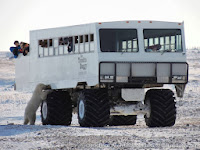November 12, 2013
With the sea-ice rapidly consolidating in western Hudson Bay this week, the polar bears are beginning to do what they’ve been waiting months to do: get out onto the frozen bay to hunt. We started our observations today with a seal-kill around 10:00. The air temperature was 15 °F (-10 °C), with little wind. A mother polar bear and her two cubs aged about two years were dining on a seal they had hauled onto the sea-ice. (The cubs here stay with their mothers for two-and-a-half years.) They were bloody-faced, but alas too far away for us to capture the gory details for electronic posterity. Some ravens were hanging around eating scraps. A few minutes later, we spotted an Arctic fox racing across the tundra toward the kill. We lost sight of it, but then another polar bear walked briskly to the kill-site. We were expecting violence, but the mother and cubs ignored the new bear and all four apparently continued to feed. Then a mother with a single cub came bounding across the tundra and swam across a short distance of open water toward the kill, but we lost track of them. As we ate lunch around noon, only the original mother and two cubs remained, and then yet another bear bounded toward the kill-site. This one put its nose in the air frequently to sniff the direction of the kill.
Polar bears mate in April and May, but implantation is delayed until around October; the fertilized egg undergoes a few divisions and then stops for 5 to 6 months. The mother is pregnant for a couple of months and gives birth around Christmastime. At brith they weigh about a a pound (half a kilogram) and will fit in the palm of your hand. The den is an extension of the womb, and the mother stays in the den and nurses them. The mother and cubs stay in their den until the beginning of March, with the mother not having eaten for about 8 months. After they emerge, the mother and cubs stay near the den for a couple of weeks. The cubs stay with their mothers for roughly two-and-a-half years before striking out on their own. During that time they nurse from her and gradually learn how to hunt seals. If they encounter a male, the female will fight him. If she loses that fight, the cubs will likely be killed. The males kill the cubs for food when they are confined to shore and have no access to the seals in the bay, but also to free the females for mating.
At 2:00 PM we did a webcast on the global impacts of climate change for students in grades 4 to 8. We watched a polar bear wander through the low willow bushes that grow on the tundra. With a beautiful red sunset off to the west at 4:00 PM, we chugged through the waning light back to the Lodge for the night.




No comments:
Post a Comment